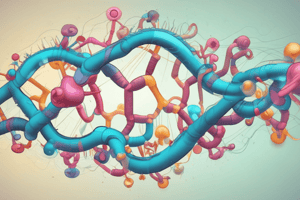Podcast
Questions and Answers
What is the role of rRNA in a ribosome?
What is the role of rRNA in a ribosome?
Structural role and part of the ribosome.
The rate of elongation in translation is 5-3 AA/s.
The rate of elongation in translation is 5-3 AA/s.
False (B)
Which of the following is a key component of protein synthesis?
Which of the following is a key component of protein synthesis?
- mRNA
- Amino acids
- tRNA
- All of the above (correct)
What are prokaryotic cells used for in biotechnology?
What are prokaryotic cells used for in biotechnology?
Eukaryotic ribosomes have a sedimentation rate of ______.
Eukaryotic ribosomes have a sedimentation rate of ______.
The Eukaryotic ribosome is larger than the prokaryotic ribosome.
The Eukaryotic ribosome is larger than the prokaryotic ribosome.
What is the start codon for translation initiation?
What is the start codon for translation initiation?
Which tRNA is specifically used for initiating protein synthesis?
Which tRNA is specifically used for initiating protein synthesis?
How many tRNAs are there in the translation process?
How many tRNAs are there in the translation process?
Flashcards are hidden until you start studying
Study Notes
Ribosomal RNA and Ribosome Structure
- rRNA plays a crucial structural role in ribosomes, essential for protein synthesis.
- Ribosomes are complexes made of rRNA and proteins, forming two subunits: a small subunit and a large subunit.
- Eukaryotic ribosomes are larger than prokaryotic ones, with sedimentation rates of 80S for eukaryotes (60S large unit + 40S small unit) versus 70S for prokaryotes (50S large unit + 30S small unit).
- Svedberg unit (S) measures sedimentation rates, influenced by size and shape.
Protein Synthesis Process
- Translation involves synthesizing proteins from mRNA information at a rate of 3-5 amino acids per second.
- Binding of mRNA and aminoacyl-tRNAs enhances translation efficiency.
- Prokaryotic cells are frequently used in biotechnology for DNA replication.
Ribosomal Functionality
- Ribosomal subunits have unique RNA lengths and associated proteins, distinguishing prokaryotic and eukaryotic ribosomes.
- The ribosome consists of three tRNA binding sites: A (aminoacyl), P (peptidyl), and E (exit), facilitating elongation during translation.
- Errors in translation can lead to protein defects or diseases, making accuracy vital due to the absence of correction factors unlike in transcription.
Translation Initiation
- Initiation starts at the AUG start codon, which codes for Methionine.
- Two types of tRNAs for Methionine: tRNAiMET for initiation and tRNAMET for elongation in the peptide chain.
- tRNAiMET specifically binds at the P site of the small ribosomal subunit, while other tRNAs enter from the A site.
- There are 21 different tRNAs, with each amino acid having a corresponding tRNA, except Methionine which has both tRNAiMET (for initiation) and tRNAMET (for elongation).
Assembly of Ribosomal Subunits
- Small and large ribosomal subunits assemble around mRNA only when there are specific mRNAs available to translate.
- Correct positioning of aminoacylated initiator tRNA at the start codon is critical for assembly and translation initiation.
Studying That Suits You
Use AI to generate personalized quizzes and flashcards to suit your learning preferences.




